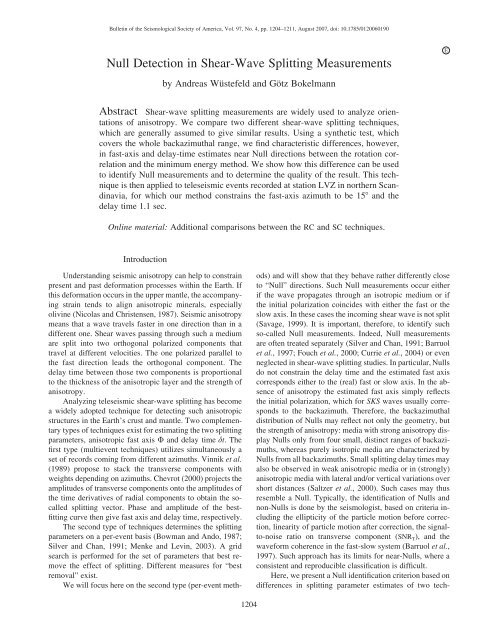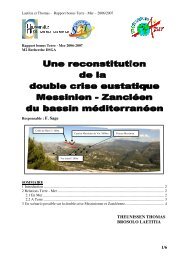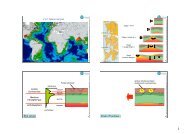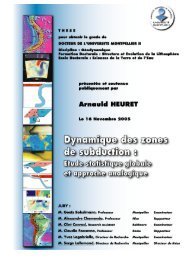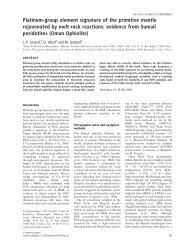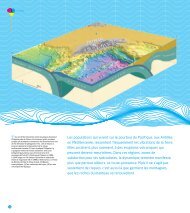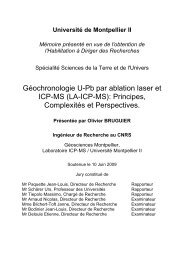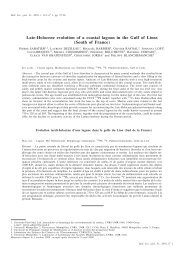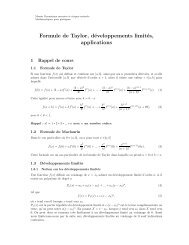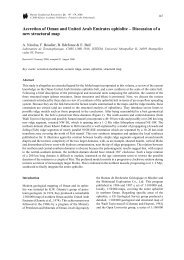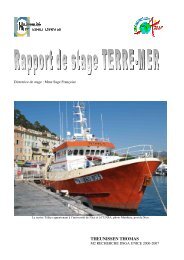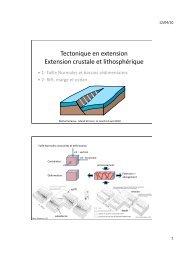Null Detection in Shear-Wave Splitting Measurements
Null Detection in Shear-Wave Splitting Measurements
Null Detection in Shear-Wave Splitting Measurements
You also want an ePaper? Increase the reach of your titles
YUMPU automatically turns print PDFs into web optimized ePapers that Google loves.
1206 A. Wüstefeld and G. BokelmannFigure 1. Synthetic splitt<strong>in</strong>g example with fast axis at 0, delay time 1.3 sec, andbackazimuth 10 (“near-<strong>Null</strong> case”) for a SNR R of 15. Upper panel displays the <strong>in</strong>itialseismograms: radial (a) and transverse (b) component, both bandpass filtered between0.02 and 1 Hz. The shaded area represents the selected time w<strong>in</strong>dow. The center paneldisplays the results for the RC technique: normalized components after rotation <strong>in</strong> RCanisotropysystem (c); radial (Q) and transverse (T) seismogram components after RCcorrection (d); particle motion before and after RC correction (e); map of correlation(f). Lower panel displays the results for the m<strong>in</strong>imum energy (SC) technique: normalizedcomponents after rotation <strong>in</strong> SC anisotropy system (g); corrected (SC) radial andtransverse seismogram component (h); SC particle motion before and after correction(i); map of m<strong>in</strong>imum energy on transverse component (j).where the “signal” level is the maximum amplitude of theradial component before correction. The 2r envelope of thecorrected transverse component gives the noise level. Forexample, <strong>in</strong> Figure 1 we obta<strong>in</strong> an SNR R of 15 and SNR T of3, respectively (compare with the seismograms <strong>in</strong> the firstpanel on the top).The backazimuth for the example <strong>in</strong> Figure 1 is 10 andit thus constitutes a near-<strong>Null</strong> measurement. Note that thetwo techniques produce different sets of optimum splitt<strong>in</strong>gparameter estimates. Although the optimum for SC recoversapproximately the correct solution, RC deviates significantly.In the follow<strong>in</strong>g, we will analyze the performance ofthe two techniques for the whole range of backazimuths.Figure 2 displays the splitt<strong>in</strong>g parameter estimates (fastaxis U RC and U SC and delay times dt RC and dt SC ) for differentbackazimuths w. This synthetic test shows that both techniquesgive correct values if backazimuths are sufficientlyfar away from fast or slow directions. Near these <strong>Null</strong> directionsthere are characteristic deviations, especially for theRC technique. Values of dt RC dim<strong>in</strong>ish systematically,whereas U RC shows deviations of about 45 near <strong>Null</strong> directions.Perhaps surpris<strong>in</strong>gly, the U RC lies along l<strong>in</strong>es that <strong>in</strong>dicatebackazimuth 45. The explanation of this behavioris that the RC technique seeks for maximum correlation betweenthe two horizontal components Q (radial) and T (transverse).However, <strong>in</strong> a <strong>Null</strong> case the energy on T is negligibleand for any test fast axis F F cos U s<strong>in</strong> U Q Q cos U • (8)S s<strong>in</strong> U cos U T Q s<strong>in</strong> U
1208 A. Wüstefeld and G. Bokelmann|DU| 45/2. Near <strong>Null</strong> directions the RC delay times arebiased toward zero. The backazimuth with m<strong>in</strong>imum dt RC isthus a further <strong>in</strong>dicator of a <strong>Null</strong> direction (Fig. 2). Teleseismicnon-<strong>Null</strong> measurements thus require the follow<strong>in</strong>gcriteria: (1) the ratio of delay-time estimates from the twotechniques (q dt RC /dt SC ) is larger than 0.7 and (2) thedifference between the fast-axis estimates of both techniques,|DU|, is smaller than 22.5. Events with SNR T 3are classified as <strong>Null</strong>s.Wolfe and Silver (1998) remark that waveforms conta<strong>in</strong><strong>in</strong>genergy at periods (T) less than ten times the splitt<strong>in</strong>gdelays are required to obta<strong>in</strong> a good measurement. However,the arc-shaped pattern of dt RC persists for smaller delaytimes. Thus, the characteristics of the backazimuthal plots(as discussed previously) can provide valuable additional <strong>in</strong>formationon the anisotropic parameters.Detect<strong>in</strong>g <strong>Null</strong>s us<strong>in</strong>g a data-based criterion providesthree advantages. First, it elim<strong>in</strong>ates subjective measuressuch as evaluat<strong>in</strong>g <strong>in</strong>itial particle motion and result<strong>in</strong>g energymap. Second, by vary<strong>in</strong>g the threshold values of DUand q, the user can change the sensitivity of <strong>Null</strong> detection.And third, the separation of <strong>Null</strong>s is necessary for futureautomated splitt<strong>in</strong>g approaches. Because available data <strong>in</strong>creaserapidly, the automation of the splitt<strong>in</strong>g process is adesirable goal <strong>in</strong> future applications and procedures.Quality Determ<strong>in</strong>ationWe furthermore use the difference between results fromthe two techniques as a quality measure of the estimation.Aga<strong>in</strong>, such a data-based measure is more objective thanvisual quality measures based on seismogram shape and l<strong>in</strong>earization(Barruol et al., 1997). In Figure 3 we compare,similar to Lev<strong>in</strong> et al. (2004), both techniques by plott<strong>in</strong>gthe difference of fast-axis estimates (|DU|) versus ratio ofdelay times (q dt RC /dt RC ) of synthetic seismograms.Based on the synthetic measurements (Fig. 2), we def<strong>in</strong>eas good splitt<strong>in</strong>g measurements if 0.8 q 1.1 and DU 8 and fair splitt<strong>in</strong>g if 0.7 q 1.2 and DU 15. <strong>Null</strong>measurements are identified as differences <strong>in</strong> fast-axis estimatesof about 45 and a small delay-time ratio q. Near thetrue <strong>Null</strong> directions the SC fast axis estimates are more robustthan the RC technique (Fig. 2). A differentiation between<strong>Null</strong>s and near-<strong>Null</strong>s is useful <strong>in</strong> the <strong>in</strong>terpretation ofbackazimuthal plots (Fig. 2). Good <strong>Null</strong>s are characterizedby a small time ratio (0 q 0.2) and, follow<strong>in</strong>g equationFigure 3. Misfit of delay-time and fast-axis estimates between RC and the SC techniquescalculated for 3185 synthetic seismograms at five different SNR R values between3 and 30 and seven <strong>in</strong>put delay times between 0 and 2 sec from all backazimuths. The<strong>Null</strong> criterion helps to identify <strong>Null</strong> measurements and at the same time gives a qualityattribute. Fair <strong>Null</strong> measurements are equivalent to near, <strong>Null</strong>s.
<strong>Null</strong> <strong>Detection</strong> <strong>in</strong> <strong>Shear</strong>-<strong>Wave</strong> Splitt<strong>in</strong>g <strong>Measurements</strong> 1209(9), a difference <strong>in</strong> fast axis estimate close to 45, that is 37 DU 53. Near-<strong>Null</strong> measurements can be classified by0 q 0.3 and 32DU 58. Rema<strong>in</strong><strong>in</strong>g measurementsare to be considered as poor quality (see Fig. 3 for furtherillustration).Real DataWe apply our <strong>Null</strong> criterion to the shear-wave splitt<strong>in</strong>gmeasurements of station LVZ <strong>in</strong> northern Scand<strong>in</strong>avia. Theanalyzed earthquakes (M w 6) occurred between December1992 and December 2005. The data were processed by us<strong>in</strong>gthe SplitLab environment (A. Wüstefeld et al., unpublishedmanuscript, 2006). This allows us to analyze eventsefficiently and to calculate simultaneously both the RC andSC technique. We mostly used raw data or, where necessary,applied third-order Butterworth bandpass filters with uppercornerfrequencies down to 0.2 Hz. Most usable events havebackazimuths between 45 and 100. Such sparse backazimuthalcoverage is unfortunately the case for many splitt<strong>in</strong>ganalyses, and we aim to extract the maximum <strong>in</strong>formationabout the splitt<strong>in</strong>g parameters from these sparse distributions.In total we analyzed 37 SKS phases from a wide rangeof backazimuths (Fig. 4). Many results resemble <strong>Null</strong> characteristicsby show<strong>in</strong>g low energy on the <strong>in</strong>itial transversecomponent, elongated to l<strong>in</strong>ear <strong>in</strong>itial particle motion and atypical energy plot. Such characteristics can be replicated <strong>in</strong>synthetic seismograms with near-<strong>Null</strong> parameters, that is,when the fast axis deviates less then 20 from backazimuth(Fig. 1). The average fast axis of the good events, as detectedautomatically and manually, is 14.3 and 14.7 for the SCand RC technique, respectively. Such orientation implies<strong>Null</strong>s at backazimuths of approximately 15, 105, 195, and285 and favorable backazimuths for splitt<strong>in</strong>g measurements<strong>in</strong> between. Indeed, good and fair splitt<strong>in</strong>g measurementsare found <strong>in</strong> backazimuthal ranges between 50 and 70 (Table1 and Fig. 4), where the energy on the transverse componentis expected to reach maximum possible values (seeequation 3) and the splitt<strong>in</strong>g can be <strong>in</strong>verted most reliably.Figure 4. <strong>Shear</strong>-wave splitt<strong>in</strong>g estimates from 33 good and fair measurements fromstation LVZ. The upper panels display fast-axis estimates for RC and SC methods. Notethat many RC estimates are situated near the dotted l<strong>in</strong>es that <strong>in</strong>dicate 45. The lowerpanels display the delay-time estimates. The solid horizontal l<strong>in</strong>es <strong>in</strong>dicate our <strong>in</strong>terpretationof the LVZ with fast axis at 15 and 1.1-sec delay time, based on the meanof the good splitt<strong>in</strong>g measurements.
1210 A. Wüstefeld and G. BokelmannTable 1Good Events of Station LVZ as Detected AutomaticallyDate Lat Long Bazi* U SC U RC dt SC dt RC SNR SC†corr RC‡01-Oct-1994 17.75 167.63 55.1 19.1 13.1 0.8 0.8 5.85 0.8917-Mar-1996 14.7 167.3 54.3 14.3 12.3 1.0 1.0 9.55 0.9305-Apr-1997 6.49 147.41 71.1 17.1 24.1 1.4 1.3 6.16 0.8806-Feb-1999 12.85 166.7 54.2 6.2 11.2 1.2 1.2 10.43 0.9710-May-1999 5.16 150.88 67.3 11.3 10.3 1.3 1.3 5.70 0.8706-Feb-2000 5.84 150.88 67.5 13.5 13.5 1.4 1.4 9.33 0.9118-Nov-2000 5.23 151.77 66.5 18.5 18.5 1.0 1.0 5.74 0.90*Bazi, backazimuth† SNR SC , signal-to-noise ratio of the SC technique.‡ corr RC , correlation coefficient of the RC technique.Also <strong>in</strong> good agreement are the detected <strong>Null</strong>s at backazimuthsbetween 80 and 110 and at about 270.Simultaneously, RC delay times systematically tend tosmaller values between backazimuths of 80 and 110, mimick<strong>in</strong>gthe trapezoidal shape <strong>in</strong> the synthetic RC delay times(Fig. 2). Mean delay time estimates of good SC and RC are1.2 and 1.1 sec. respectively.Discussion and ConclusionsWe have presented a novel criterion for identify<strong>in</strong>g <strong>Null</strong>measurements <strong>in</strong> shear-wave splitt<strong>in</strong>g data based on two <strong>in</strong>dependentand commonly used splitt<strong>in</strong>g techniques. The twotechniques behave very differently near <strong>Null</strong> directions,where the RC technique systematically fails to extract thecorrect values both for the fast-axis azimuth U RC and delaytime dt RC . That technique should therefore not be used as a“stand-alone” technique. On the other hand, the comparisonof the two techniques is valuable for f<strong>in</strong>d<strong>in</strong>g <strong>Null</strong> events.The backazimuths of <strong>Null</strong>s ambiguously <strong>in</strong>dicates either fastor slow direction. Thus, a <strong>Null</strong> measurement yields limited,yet important, constra<strong>in</strong>ts on anisotropy orientation, especiallyif the backazimuthal coverage of the station is onlysparse. Furthermore, <strong>Null</strong>s from a wide range of backazimuths<strong>in</strong>dicate either the lack of (azimuthal) anisotropy orweak anisotropy, at the limit of detection. Restivo and Helffrich(1998) analyzed the splitt<strong>in</strong>g procedure for effects ofnoise. They conclude that for small splitt<strong>in</strong>g filter<strong>in</strong>g doesnot necessarily result <strong>in</strong> more confident estimates of splitt<strong>in</strong>gparameters, s<strong>in</strong>ce narrow bandpass filters lead to apparent<strong>Null</strong> measurements. For SNR above 5 our criterion detects<strong>Null</strong> measurements and classifies near-<strong>Null</strong>s. Good eventscan still be obta<strong>in</strong>ed but only for exceptionally good SNR orwith backazimuths far away oriented with respect to theanisotropy axes (where the transverse amplitude is larger;see equation 3).The comparison of the two shear-wave splitt<strong>in</strong>g techniquesallows assign<strong>in</strong>g a quality to s<strong>in</strong>gle measurements(Fig. 1). Furthermore, the jo<strong>in</strong>t two-technique analysis of allmeasurements (Fig. 2) yields characteristic variations ofsplitt<strong>in</strong>g parameter estimates with backazimuth. This variationcan be used to extract the maximum <strong>in</strong>formation fromthe data, and to decide whether a more complex anisotropythan a s<strong>in</strong>gle layer needs to be <strong>in</strong>voked to expla<strong>in</strong> the observations.The practical steps for this should be: first, assumea s<strong>in</strong>gle-layer case with the most probable fast directionbased on the good measurements. Second, verify that<strong>Null</strong>s measurements occur near the correspond<strong>in</strong>g <strong>Null</strong> directions<strong>in</strong> the backazimuth plot (Fig. 4). In the vic<strong>in</strong>ity ofthese <strong>Null</strong> directions, the splitt<strong>in</strong>g parameter estimates U SCand dt SC should show a larger scatter with a tendency towardlarge delays. For dt RC we expect to f<strong>in</strong>d an arc-shaped variationwith backazimuth that should have its m<strong>in</strong>imums nearthe assumed <strong>Null</strong> directions. If these conditions are met, aone-layer case can reasonably expla<strong>in</strong> the observations. Onthe other hand, good events that deviate from these predictionsmay require more complex anisotropy (multilayer caseor dipp<strong>in</strong>g layer). Applied to station LVZ <strong>in</strong> northern Scand<strong>in</strong>avia,we were thus able to comfortably characterize theanisotropy by a s<strong>in</strong>gle anisotropic layer with a fast axis orientedat 15 and a delay time of 1.1 sec.ReferencesBarruol, G., P. G. Silver, and A. Vauchez (1997). Seismic anisotropy <strong>in</strong> theeastern US: Deep structure of a complex cont<strong>in</strong>ental plate, J. Geophys.Res. 102, no. B4, 8329–8348.Bowman, J. R., and M. Ando (1987). <strong>Shear</strong>-wave splitt<strong>in</strong>g <strong>in</strong> the uppermantlewedge above the Tonga subduction zone, Geophys. J. R. Astr.Soc. 88, 25–41.Brechner, S., K. Kl<strong>in</strong>ge, F. Krüger, and T. Plenefisch (1998). Backazimuthalvariations of splitt<strong>in</strong>g parameters of teleseismic SKS phases observedat the broadband stations <strong>in</strong> Germany, Pure Appl. Geophys.151, 305–331.Chevrot, S. (2000). Multichannel analysis of shear wave splitt<strong>in</strong>g, J. Geophys.Res. 105, no. B9, 21,579–21,590.Currie, C. A., J. F. Cassidy, R. D. Hyndman, and M. G. Bostock (2004).<strong>Shear</strong> wave anisotropy beneath th Cascadia subduction zone and westernNorth American Craton, Geophys. J. Int. 157, 341–353.Fouch, M. J., K. M. Fischer, E. M. Parmentier, M. E. Wysession, and T. J.Clarke (2000). <strong>Shear</strong> wave splitt<strong>in</strong>g, cont<strong>in</strong>ental keels, and patternsof mantle flow, J. Geophys. Res. 105, no. B3, 6255–6275.Fukao, Y. (1984). Evidence from core-reflected shear waves for anisotropy<strong>in</strong> the earth’s mantle, Nature 309, 5970, 695.Lev<strong>in</strong>, V., D. Drozn<strong>in</strong>, J. Park, and E. Gordeev (2004). Detailed mapp<strong>in</strong>g
<strong>Null</strong> <strong>Detection</strong> <strong>in</strong> <strong>Shear</strong>-<strong>Wave</strong> Splitt<strong>in</strong>g <strong>Measurements</strong> 1211of seismic anisotropy with local shear waves <strong>in</strong> southeastern Kamchatka,Geophys. J. Int. 158, no. 3, 1009–1023.Menke, W., and V. Lev<strong>in</strong> (2003). The cross-convolution method for <strong>in</strong>terpret<strong>in</strong>gSKS splitt<strong>in</strong>g observations, with application to one and twolayeranisotropic earth models, Geophys. J. Int. 154, no. 2, 379–392.Nicolas, A., and N. I. Christensen (1987). Formation of anisotrophy <strong>in</strong>upper mantle peridotites: a review, <strong>in</strong> Composition Structure and Dynamicsof the Lithosphere Asthenosphere System, K. Fuchs and C.Froideveaux (Editors), American Geophysical Union, Wash<strong>in</strong>gton,D.C., 111–123.Ozalaybey, S., and M. K. Savage (1994). Double-layer anisotropy resolvedfrom S phases, Geophys. J. Int. 117, 653–664.Restivo, A., and G. Helffrich (1999). Teleseismic shear wave splitt<strong>in</strong>g measurements<strong>in</strong> noisy environments, Geophys. J. Int. 137, no. 3, 821–830.Saltzer, R. L., J. B. Gaherty, and T. H. Jordan (2000). How are verticalshear wave splitt<strong>in</strong>g measurements affected by variations <strong>in</strong> the orientationof azimuthal anisotropy with depth? Geophys. J. Int. 141,374–390.Savage, M. K. (1999). Seismic anisotropy and mantle deformation: whathave we learned from shear wave splitt<strong>in</strong>g, Rev. Geophys. 37, 69–106.Silver, P. G., and W. W. Chan (1991). <strong>Shear</strong> wave splitt<strong>in</strong>g and subcont<strong>in</strong>entalmantle deformation, J. Geophys. Res. 96, no. B10, 16,429–16,454.Teanby, N., J. M. Kendall, and M. van der Baan (2003). Automation ofshear-wave splitt<strong>in</strong>g measurements us<strong>in</strong>g cluster analysis, Bull. Seism.Soc. Am. 94, 453–463.V<strong>in</strong>nik, L. P., V. Farra, and B. Romanniwicz (1989). Azimuthal anisotropy<strong>in</strong> the earth from observations of SKS at GEOSCOPE and NARSbroadband stations, Bull. Seism. Soc. Am. 79, no. 5, 1542–1558.Wolfe, C. J., and P. G. Silver (1998). Seismic anisotropy of oceanicupper mantle: <strong>Shear</strong> wave splitt<strong>in</strong>g methodologies and observations,J. Geophys. Res. 103, no. B1, 749–771.Geosciences MontpellierUniversité de Montpellier II34095 Montpellier, Francewueste@gm.univ-montp2.frbokelmann@gm.univ-montp2.frManuscript received 19 September 2006.


